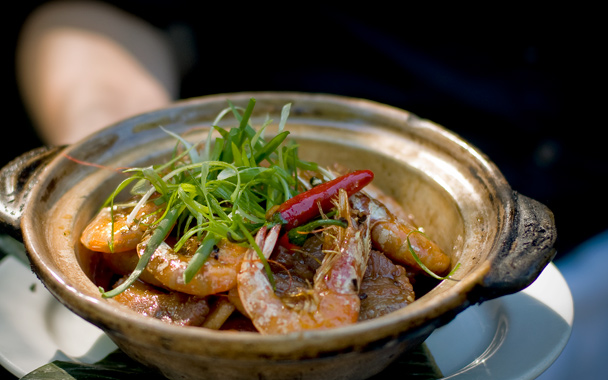This pork belly is undercooked,” I whispered across the table. I was having dinner at Monsoon East, a new Vietnamese restaurant in Bellevue, Washington, and this meat, served in a clay pot with shrimp and caramel-laced broth, was fighting my jaw. Should I say something?
While I debated, owner Eric Banh (his sister, Sophie Banh, is Monsoon’s chef) came over and threw down the gauntlet. “Just so you know,” he said, “The pork belly is supposed to be chewy. I wanted to add a note of authenticity here. In Asia, people eat with the front teeth. Americans eat with the back teeth.” While I chewed and enjoyed the next piece of pork, I thought about my front teeth. They do seem to go woefully underused. I remembered the chapter in Fuchsia Dunlop’s Shark’s Fin and Sichuan Pepper where she takes her parents to lunch and watches them struggle with rabbit ears, goose intestines, and ox tripe.
“Why do we eat things like crunchy beef tripe?” Banh asked me later, rhetorically. “Is it because we don’t know how to make it softer? That’s not true. You go to a Vietnamese restaurant in Vietnam, you would never see a piece of meat braised to the ‘melt in your mouth’ that people here yee-ha about.”
“So how do your non-Asian customers like the pork belly?” I asked.
“A lot of people complained. Now, guess what? We braise it a little more tender. My sister, even my crew at Monsoon, they think I overcook meat all the time.”
As for “eating with the front teeth,” Banh credits Toronto chef Susur Lee—now at Shang in New York—with the phrase. I gave Lee a call. “Chicken feet, jellyfish, beef tendon, pork tendon,” Lee rattled off. “You can hear that crunch, that sound, it makes you say, ‘Hmm, this is delicious-sounding.’ Eating food is not just about the smell and the taste and the eye.”
Has Lee had any more success than Banh in introducing this texture to Western customers? “Slowly but surely,” he said. “I’ve been making this pig-ear terrine. When I first made it, nobody touched it.” He changed the name to “pork terrine,” and now it’s a hit.
This made me realize that after a decade in food writing, my tastes are still more provincial than I’d like to believe. One pig-ear salad, please, and make it snappy.




 Pinterest
Pinterest


